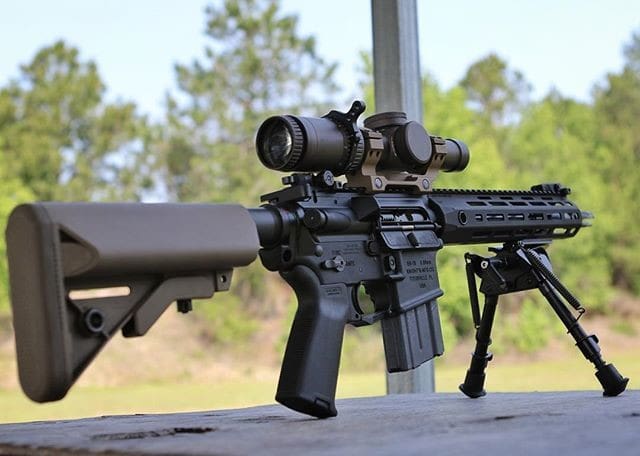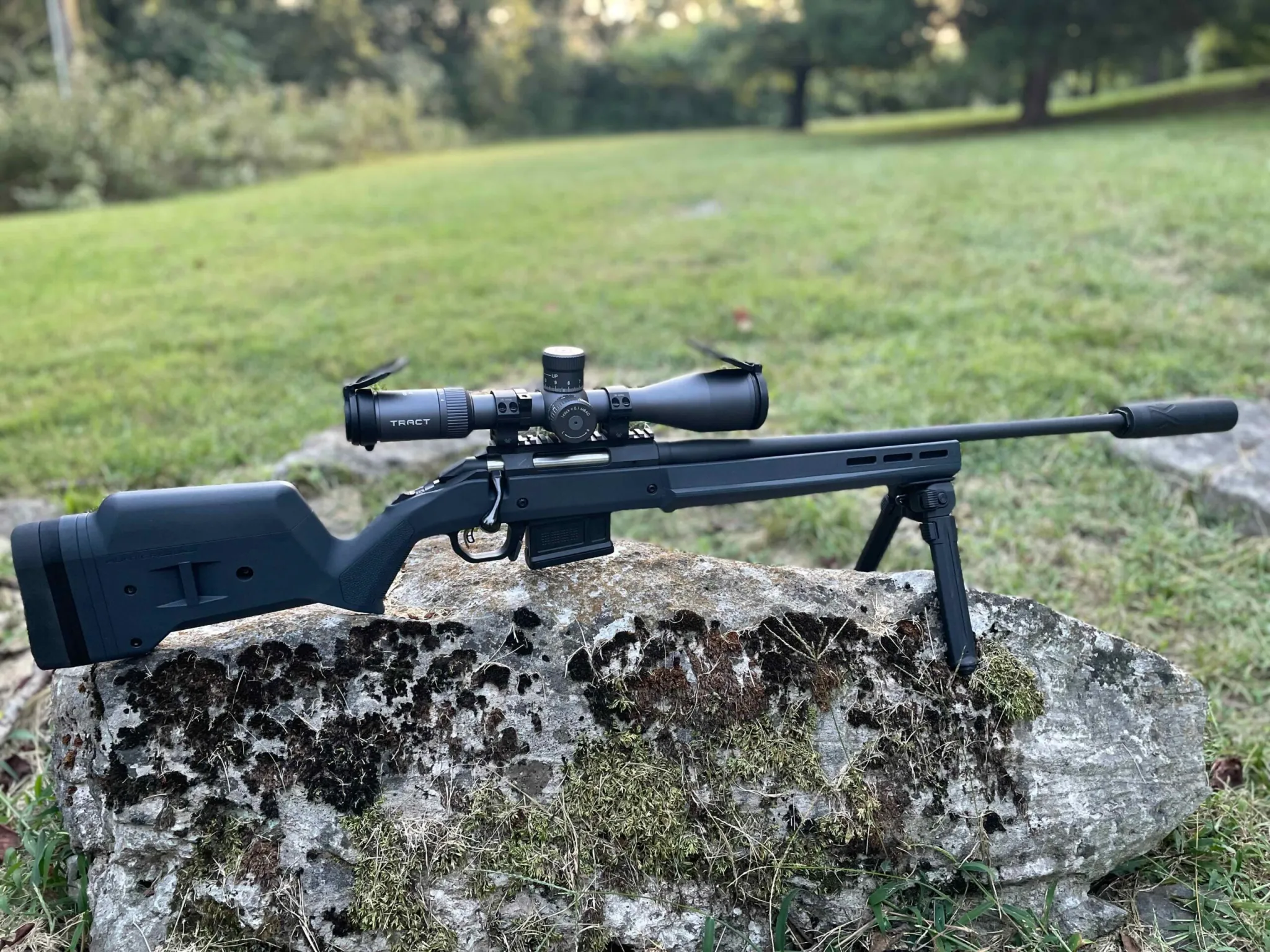The AR-15 is one of the most versatile firearms platforms in the world, available in a myriad of calibers and configurations. Without the proper optic, though, the AR’s flexibility — for hunting, self-defense, target shooting or plinking — is easily greatly diminished. Is the Vortex Razor HD Gen II 1-6×24 variable magnification rifle scope up to those jobs?
It’s certainly the right magnification. The 1-6x24mm optic is one of the most versatile configurations available, allowing for close to long range shooting in an all-in-one package.
Over the past two months I spent some serious trigger time with the Vortex Razor HD Gen II scope. I tested it from close quarters battle distances out to 550 yards. I also mounted it to my rifle for my full-day tactical rifle courses. 
The Vortex optic ships from the factory in a matte “stealth shadow” anodized finish, complete with a battery for the red dot function, an Allen wrench and a cleaning cloth.
The Razor HD Gen II offers shooters the standard elevation and windage ½ MOA adjustment turrets, protected by aluminum covers. It features an 11-setting red dot illumination adjustment. Magnification dials smoothly from a true 1x up to 6x.
The Razor HD is set to a 100-yard parallax with an adjustable diopter focus. The adjustment ring is tighter than Scrooge McDuck, but loosens up acceptably after regular use.
There are three available options for the reticle: MOA, MRAD and BDC. Testing was conducted with the MOA reticle.
The Razor uses a second focal plane (SFP) reticle, which keeps it the same size regardless of magnification. It comes with 4 MOA subtensions which enable easy holdovers, windage adjustment and distance estimation.
The optic really lives up to its “high definition” name. The sight picture was sharp and crystal clear at nearly all distances.
The red dot’s 11 brightness settings feature an an “off” click between each. It makes it fast and easy to return to your desired brightness level. A locking feature also prevents accidental adjustment.
The brightness adjustment creates options across the full range of lighting conditions, from zero light (where the reticle would otherwise be invisible) to the brightest Texas sunshine. With the red dot at low zoom, the optic can be used as a both an eyes-open reflex sight or, on higher zoom, a squinty-eyed precision optic.
The Vortex Razor HD Gen II lacks the multi-year battery lifespan of regular red dot sights. The battery drained within four days of constant-on use. On the high brightness setting, the red dot bleeds into the vertical crosshair of the reticle, distracting you from your sight picture
To test the optic I shot a preliminary zero at 25 yards for a 100-yard zero with my piston AR. After that, I verified my zero at 100 yards, zeroed the turrets, and performed a box test to ensure that optic was tracking correctly.
To check the clarity of the sight picture, I shot my AR at 100, 200, 300, 400, 500 and 550 yards, utilizing the full range of magnification adjustment. Clocking a 15-mph wind at three o’clock, I played with wind drift adjustment subtensions and holdovers as well as adjustment in the turrets.
The Vortex Razor enabled an easy first or second-round hit on all targets (nine-inch diameter steel plates). The crisp, clear picture through excellent glass and the fine reticle with small-yet-bright red dot in the center made for confident target engagement and easy precision.
With an MSRP of $1,999 ($1,399 at Brownell’s), the Vortex Razor HD Gen II Optic isn’t cheap, especially when you forget to turn the dot off and have to buy Costco-sized battery packs. It’s also a bit on the chunky side at 25.2 ounces (sans mount). But it is the last optic you’ll need if you want a high-quality, lifetime-warrantied, do-it-all optic on your do-it-all rifle.
SPECIFICATIONS: Vortex Razor HD Gen II 1-6×24 Riflescope
Hard Anodized – stealth shadow
Power x Obj. Lens: 1-6x24mm
Reticle: VMR 2 (½ MOA adjustment)
Lens Coating: XR™Plus Fully Multi-Coated
Tube Diameter: 30mm
Eye Relief: 4 inches
Focal Plane: Second
Length: 10.1 inches
Weight: 25.2 ounces
MSRP: $1,999 ($1,399 at Brownell’s)
RATINGS (out of five stars):
Fit, Finish, Build Quality * * * *
Extremely well-built. The only issue is the bleeding of the red dot into the vertical crosshair at full brightness.
Optical Quality * * * * *
The optic lives up to its HD name: extremely clear image at all distances
Reticle * * * * *
Standard and easy to use for windage and hold overs.
Overall * * * *
An endlessly useful optic — until the battery runs out. At the two-grand price point, the Vortex should come with covers and a mount. But the red dot bleed over into the reticle, limited battery life and heavy-ish weight keep this scope from achieving perfection.












looking for something just like this, but think ill go with the leupold. vortex makes it’s name on warranty yet the one and only time i needed warranty service on my vortex, i got the runaround from the company. Leupold on the other hand has been stellar and has simply replaced my 1980s scope with a brand new one. Plus Leupold is made in America. Most if not all of Vortex is made overseas with a majority of their products made in China.
I’ve been doing a lot of testing with the 300 blk in subsonic form. I needed something that didn’t disturb an area with gun shot noise. Whitetail depredation, qdm, and hogs over the last four years. I’ve tried all kinds of bullets, jacketed, lead, round nose, spitzer about 65 different bullets now and even made some hollow point designs. The blackout at subsonic velocity IS NOT SUITABLE for game. Sure you shot one deer or your uncle’s kids friend shot A hog. I’m into the hundreds of deer and hogs and it’s not reliable or even useful on game animals. Even if you get a bullet to expand it’s not moving fast enough to deliver any shock value. Spine shots are ok at best and probably the best option for this caliber outside of head shots. A blackout will penetrate end to end of a hog or a deer. But they will run a long way. I like the round and it’s platforms. My Ruger is a half inch gun with 220 subs all day. Buts it’s just too marginal in it’s killing power. For all those touting it as a 300 yd gun…try this on. A 220gr bullet at around 1000fps zeroed at 75yds is 2 in high at 50 and 2.5 low at 100. That’s 4.5 inch’s margin either way. That equates to a miss on a deer head if you’re off on range estimation by 25 yds. (My experience is the average hunter can’t accurately guess range in the field). This week I’m retiring the 300 blackout to the range fun gun and nothing more!
“When I was a govt thug I learned to shoot so I know you don’t need your rights” heard THAT before sic semper tyrannis
It’s perfect!! I have a heart rate monitor on my phone. Put finger on the light thingy and, heartbeat! Works every time. Well, almost every time, once I get my finger set just right after several tries. /sarc Wonder what is the assumed variance of not being able to draw the pistol first time. Well that’s OK also. Don’t want anybody getting hurt now do we .
If sporting and fairness were the most important things about hunting, I’d hunt people. That’s about as fair as you can get.
Based on recent terrorist activities, English cops don’t need guns. They need spike strips.
thats an AK in the picture so not sure why i should believe this.
Another 2 minutes and my ammo is half price.
“and nothing crew served.”
Come on now! I really wanted to start a discussion about the viability of the Mutually Assured Destruction policy for home defense. “If you attack me, I’ll blow up you, your crew, and the whole city too.”
Bwa ha ha ha ha!